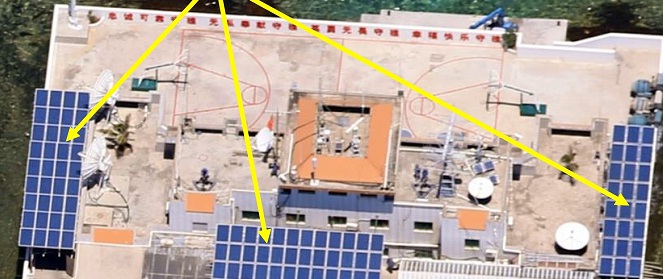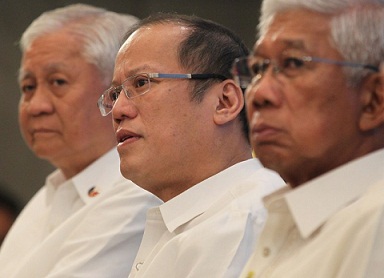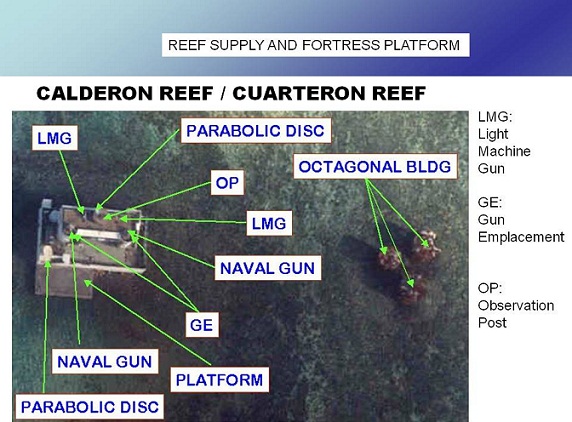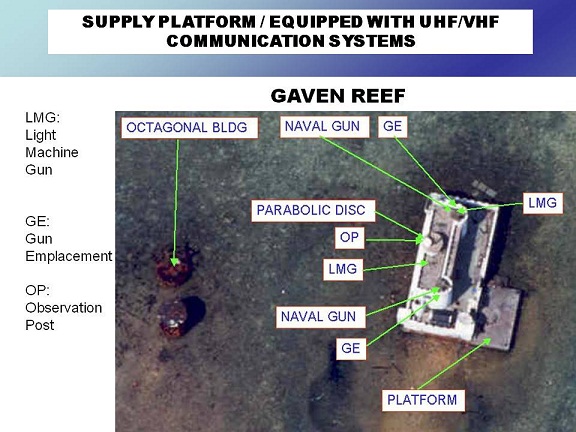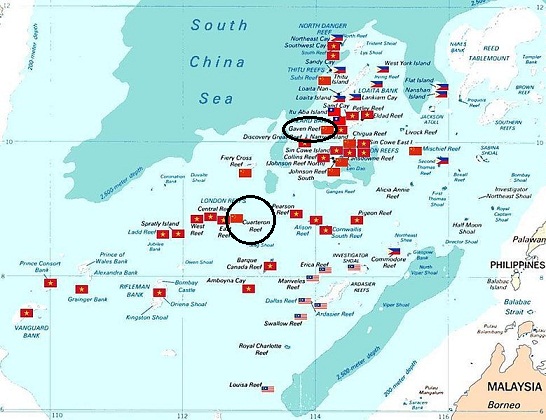In the power point presentation Rep. Ashley Acedillo of the Magdalo Party showed last Wednesday, he compared the massive fortification and expansion of the Chinese of their occupied reefs in the disputed Spratlys area in the South China with the miserable state of the islands and reefs occupied by the Philippines.
Acedillo, in a privilege speech titled “Our country is in grave danger,”questioned what seems to be a government policy of benign neglect in our occupied territories in Spratlys.
“With an Air Force that can’t protect our air space and a Navy that can’t protect our maritime interest, claimant countries have accelerated their creeping occupation of our islands,” said Acedillo, formerly an Air Force Officer who was detained for seven years for rebelling against Gloria Arroyo in what was known as “The Oakwood Mutiny.”
Furthermore, Acedillo said, there is no allocation for improvement of facilities in our occupied areas in the Spratlys in the Department of National Defense budget for 2015.
Acedillo said his understanding is that the DND does not want to go against the policy of the Department of Foreign Affairs of adhering to the provision of the 2002 Declaration of the Conduct in the South China Sea signed by the Association of Southeast Asian Nations of ASEAN and China which calls on claimant countries to “ undertake to exercise self-restraint in the conduct of activities that would complicate or escalate disputes and affect peace and stability including, among others, refraining from action of inhabiting on the presently uninhabited islands, reefs, shoals, cays, and other features and to handle their differences in a constructive manner.”
In the recent Asean Foreign Ministerial Meeting, Foreign Secretary Albert del Rosario re-packaged the DOC provision adopting the proposal of Danny Russel, assistant secretary of state for East Asian and Pacific affairs calling for a “moratorium” on provocative actions in the South China Sea.
It didn’t fly, contrary to DFA’s press release as most of the ASEAN countries (except the Philippines) didn’t want to be seen as American proxies.
Acedillo enumerated the current state of occupation in the Spratlys which consists of 97 “features” which could be an island, a reef, a rock, or a cay. Some may be visible during low tide and submerged during high tide.
Acedillo said 41 features are occupied and 56 are unoccupied.
Of those occupied “features” the Philippines has structures and personnel in seven islands and two shoals. Vietnam occupies the most number with 21; Malaysia, three and Taiwan occupies only one, It Aba, the largest island in the Spratlys.
China, whose nine-dash-line map covers almost the entire South China Sea occupies seven features.
Another Spratly -claimant, the oil-rich Brunei does not occupy any island in the Spratlys.
Although China’s aggressive strategy of taking control of territories in the South China Sea goes way, way back (in 1974 battle with Vietnam over the Paracels, China sank several Vietnamese warships killing 53 of their crew), the Philippines became the target of China’s expansionism starting in 1995 with the occupation of the Mischief Reef, also known as Panganiban Reef.
Acedillo said “In 1995 the Chinese military occupied Mischief Reef and built wooden structures. The Philippine government protested this action. Then in 1998, China added more structures that resembled military installations. To date, this structure is now a three storey building equipped with solar panels, power generators, weather radars, communication equipment, and heavy machine guns. “
Acedillo further said China are fortifying their facilities in other areas they occupy among them, Subi Reef,Fiery Cross Reef, Cuarteron Reef, and Chigua Reef.
“Recently, China was found conducting land reclamation and construction on four of its occupied reefs namely: Johnson Reef, Chigua Reef, Cuarteron Reefs and Gaven Reef. It is suspected that they are building and airfield and naval facility at Mabini Reef that will pose a serious threat to our capability to sustain our garrisons at the Kalayaan Island Group of KIG ,” he added.
Acedillo showed the sorry state of our occupied territories in KIG: “Ang nakakalungkot po dito ay ang Pilipinas hindi nag-develop ng kahit alin man sa mga islang hawak natin. Ito raw ay alinsunod sa Declaration on the Conduct of Parties in the South China Sea na pinirmahan ng buong Asean at ng China nung 2002. (What is sad here is that the Philippines did not develop any of the islands we occupied. I was told this is in compliance with the Declaration on the Conduct of Parties in the South China Sea that was signed by all ASEAN members and China in 2002.)”
Acedillo said, “Based on this precedent, similar construction might also be done in the Scarborough Shoal or in other areas in our Kalayaan Island Group of KIG.”
To secure our territory, Acedillo said “the ideal joint concept to adopt is defense- in-depth which is anchored on the principle of pressing the border out by engaging the enemy as far out as possible.”
He elaborated on the defense-in-depth concept: “The system incorporates a sequence of lines: detection line, decision line and interception line, and requires four basic steps: 1. detect the presence of airborne objects, aircraft, or missiles; 2. identify them as friendly or hostile; 3. intercept and examine those not identified as friendly; and 4. neutralize those identified as hostile.”
“This joint concept, applies in tandem with our Navy’s active archipelagic defense strategy. Situational awareness will be provided by the air defense radars, long range patrol aircraft and over the horizon radars. Hostile forces are held to a ‘no give zone’ within the range of attack craft and ground-based missile. Maneuver forces composed of frigates corvettes, and fighter aircraft, shall simultaneously attack from different locations to swarm the opposing force in multiple directions. “
What is preventing the government from adopting and implementing it?
